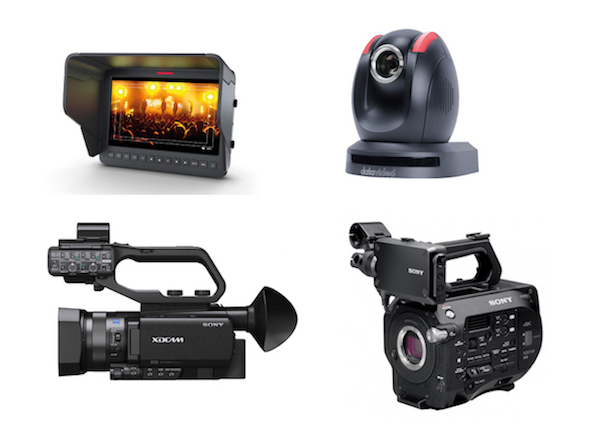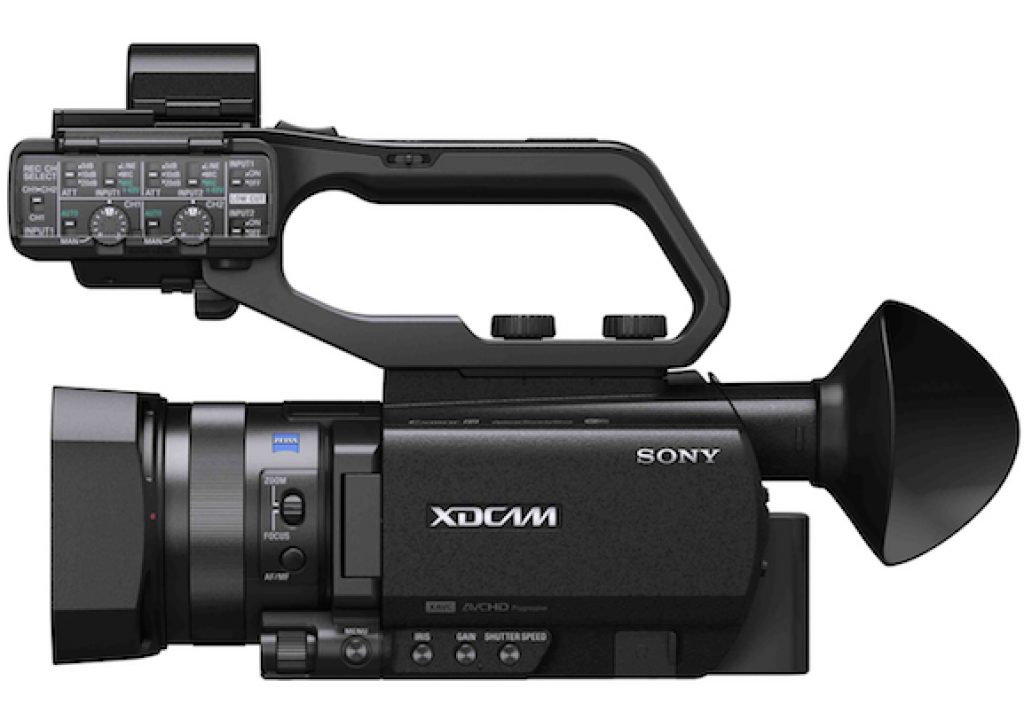The goal was to compare several cameras that made me curious for studio use with a greenscreen using a NewTek TriCaster virtual set. Although robotic cameras are not generally appropriate for virtual sets, I was also very curious to test one for other uses. So we tested —and recorded— with Blackmagic Studio 4K, Datavideo PTC–150 PTZ, Sony PXW-X70 & PXW-FS7 cameras in Midtown Video’s studio in Miami, Florida. Ahead are the details, recordings, and the two other cameras I didn’t get to test in studio yet.

The goal was to compare several cameras that made me curious for studio use with a greenscreen using a NewTek TriCaster virtual set. Although robotic cameras are not generally appropriate for virtual sets, I was also very curious to test one for other uses. So we tested —and recorded— with Blackmagic Studio 4K, Datavideo PTC–150 PTZ, Sony PXW-X70 & PXW-FS7 cameras in Midtown Video’s studio in Miami, Florida. Ahead are the details, recordings, and the two other cameras I didn’t get to test in studio yet.
I thank Midtown Video and Rodolfo Matamoros for their help with this. Midtown Video is a leading pro video dealer and rental house in Miami Florida, and generously agreed to help with their studio, lights, and greenscreen. (Midtown Video is an authorized dealer for all of the cameras used and the complete TriCaster line.) Rodolfo Matamoros was kind enough to bring his Sony PXW-X70 for comparison. Blackmagic sent the 4K Studio Camera and Datavideo sent the PTC–150 robotic PTZ (pan/tilt/zoom) camera, both of which I’ll review soon. I originally hoped to include a Panasonic GH4 (which after recent firmware updates can fortunately now offer native 23.976p, 25p and 29.97p live over its Micro HDMI port) and a Sony A7s, but the two friends who own them were unavailable during the time window we had available. As a result, Midtown Video offered its Sony PXW-FS7 as one more source.
Although I originally considered doing the tests at 23.976p, the PTC–150 doesn’t offer that framerate. I thought about 25p (since all four tested models are “worldcam”), but I wanted to avoid any potential flicker with the 60Hz lighting, so I went for the sure bet that is a common denominator framerate among all of the cameras: 29.97p. All cameras were connected to the TriCaster via SDI. Both the Blackmagic 4K Studio Camera and the Datavideo PTC–150 are fortunately able to deliver native 1080p29.97 over SDI, so that’s how we set those cameras, and the TriCaster input for those two sources were set at “1080/30p” since the TriCaster still rounds non-integer framerates in its menus. With those two inputs, no reverse telecine (pulldown removal) was required. The two Sony sources output 1080PsF29.97 with a 2:2 pulldown, so we put the TriCaster input setting for those to at “1080p30 PsF” and the TriCaster gracefully performed reverse telecine (pulldown removal) on the fly, avoiding unnecessary de-interlacing.
Midtown Video’s TriCaster specialist Virgilio (“Virge”) Castillo was at the controls. Midtown Video’s Alex (the bearded newscaster) wore the tweed jacket I brought to see which cameras best resisted any possible moiré. We set the TriCaster to record at its minimum compression: what the TriCaster calls “QuickTime 4:2:2” and more specifically is MPEG2 4:2:2 High Profile 8 bit, which are labeled as XDCAM HD422 as I read in the QuickTime Pro 7’s Inspector. The video payload is actually 55.9 megabits per second, and the total payload is 60.51 megabits per second according to the Inspector. Those are the files I uploaded to YouTube, and YouTube recompressed them to H.264 for streaming. Be sure to set playback for 1080p and full screen.
We didn’t attempt to match the cameras. Our only intention was to get the ideal exposure of each, and for Virgilio and the TriCaster to get the best possible key. All cameras were able to do that at 0 dB with the exception of the Blackmagic Studio 4K camera, which needed to be set to +12 dB. According to Blackmagic sales engineer, on this camera (at least with the current firmware), 0 dB in the menu is equivalent to –6 dB on other cameras, so based upon that, I extrapolate that +12 dB on this camera is like +6 on other cameras.
Blackmagic Studio 4K camera
Datavideo PTC–150 pan/tilt/zoom robotic camera
Although the Datavideo PTC–150 footage is definitely in proper focus, one side of the jacket looks softer than the other side of the same jacket, and this only happened with that particular camera. As of publication time of this article, Datavideo has not yet commented as whether this is considered typical or not. I will update this when I receive a response, and will also include it in the upcoming review article.
Sony PWX-X70 camcorder
Sony PWX-FS7 camcorder
Upcoming articles, reviews, and books
Stand by for upcoming articles, reviews, and books. Sign up to my free mailing list by clicking here.
Si deseas suscribirte a mi lista en castellano, visita aquí. Si prefieres, puedes suscribirte a ambas listas (castellano e inglés).
Books, consulting, articles, seminars & audio programs
Contact Allan Tépper for consulting, or find a full listing of his books, articles and upcoming seminars and webinars at AllanTepper.com. Listen to his CapicúaFM program at CapicúaFM.com in iTunes or Stitcher.
My latest book (paperback + ebook)
My most recent book is available in two languages, and in paperback as well as an ebook. The ebook format is Kindle, but even if you don’t have a Kindle device, you can read Kindle books on many other devices using a free Kindle app. That includes iPad, Android tablets, Mac computers, and Windows computers. Although generally speaking, Kindle books are readable on smartphones like Androids and iPhones, I don’t recommend it for this particular book since it contains both color photos and color comparison charts. The ebook is also DRM-free.
In English, it’s The Castilian Conspiracy. Click here and you will be automatically sent to the closest Amazon book page to you based upon your IP address. Or request ISBN–10: 1456310232 or ISBN–13: 978–1456310233 in your favorite local bookstore.
En castellano, se llama La conspiración del castellano. Haz clic aquí para llegar al instante a la página del libro correspondiente a tu zona y moneda en Amazon, según tu dirección IP. De lo contrario, solicítalo en tu librería preferida con los ISBN–10: 1492783390 ó el ISBN–13: 978–1492783398.
FTC disclosure
No manufacturer is specifically paying Allan Tépper or TecnoTur LLC to write this article or the mentioned books. Some of the other manufacturers listed above have contracted Tépper and/or TecnoTur LLC to carry out consulting and/or translations/localizations/transcreations. Many of the manufacturers listed above have sent Allan Tépper review units. So far, none of the manufacturers listed above is/are sponsors of the TecnoTur programs, although they are welcome to do so, and some are, may be (or may have been) sponsors of ProVideo Coalition magazine. Some links to third parties listed in this article and/or on this web page may indirectly benefit TecnoTur LLC via affiliate programs.
Copyright and use of this article
The articles contained in the TecnoTur channel in ProVideo Coalition magazine are copyright Allan Tépper/TecnoTur LLC, except where otherwise attributed. Unauthorized use is prohibited without prior approval, except for short quotes which link back to this page, which are encouraged!


